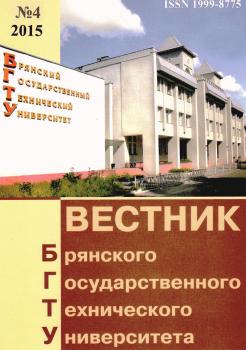employee
Bryansk, Bryansk, Russian Federation
Chemically active components which are available both in structure of material of a blanket and in lubricant, decay under the influence of temperature, a force field of a solid body and catalytic impact of a svezheobnazhenny surface of metal, are allocated in the form of active agents who react and form the modified layer. The modified layer has smaller (in comparison with the main metal) resistance to shift owing to what decrease in coefficient of friction and replacement of intensive adhesive wear softer corrosion and mechanical is provided. The condition of details of the rolling bearing in the presence of the modified layer does not change during all service life. However in case of a leakage of lubricant or loss in it chemically active components the modified layer is not formed that leads to metal contact and failure of the bearing. Metal contact causes sharp temperature increase, and also mechanical damages to a type of zadir on bodies of swing and nicks on the rings received as a result of shock loadings. Intensity of wear of details of the rolling bearing is influenced substantially by the process temperature which depends on the relative speed of sliding and the normal squeezing force. In process of temperature increase of process the speed of education and a share of the modified layer increase. Critical value of temperature determines a lubricant scope. The concentration of an active component in lubricant is higher, the wear resistance of the rolling bearing is higher. When toughening the mode of friction there is a competition of two processes – educations and wear of the modified layer and if wear prevails, then inevitably there will be a metal contact leading to failure of the bearing.
lubricant, couple of friction, friction coefficient, the rolling bearing, tribotechnical tests, the modified layer, intensity of wear
1. Gorlenko, A.O. A test method of rolling bearings on friction and wear / A.O. Gorlenko, M. L. Klyushnikov, S. P. Shets//Bulletin of Bryansk state technical university. - 2010. - No. 1(25). - P. 10-12.
2. Shets, S. P. Tribological tests of lubricants in rolling bearings / S. P. Shets//the Bulletin of Bryansk state technical university. - 2011. - No. 1(29). - P. 32-34.
3. Buyanovsky, I.A. Boundary greasing / I.A. Buya-novsky, I.G. Fuchs, T.N. Shabalin. - M.: Oil and gas, 2003. - 248 p.
4. Kragelsky, I.V. Frictional units of cars: reference book / I.V. Kragelsky, N. M. Mikhin. - M.: Mechanical engineering, 1984. - 280 p.
5. Shets, S. P. Increase of the pressurizing ability of cuffs a combination with magnetoliquid consolidation / S. P. Shets//the Bulletin of Bryansk state technical university. -2007. - No. 2(14). - P. 27-31.
6. Tribology bases (friction, wear, greasing): studies. for техн. higher education institutions / A.V. Chichinadze, E.D. Brown, N. A. Bush [etc.]; under a general edition of A.V. Chichinadze. - 2nd prod., reslave. and additional - M.: Mechanical engineering, 2001. - 664 p.
7. Vasilyev, Yu.N. Model of jamming at boundary greasing / Yu.N. Vasilyev//Settlement and experimental methods of an assessment of friction and wear. - M.: Science, 1980. - P. 65 - 69.












